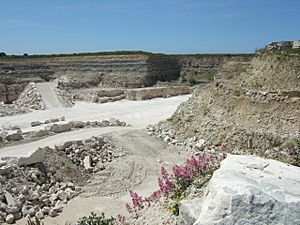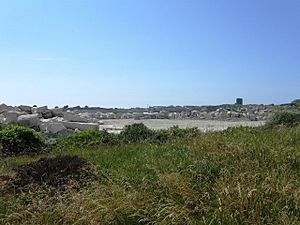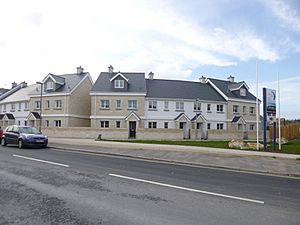Perryfield Quarry facts for kids
Perryfield Quarry is a special place on the Isle of Portland in Dorset, England. It's a busy stone quarry where workers dig out valuable stone. But it's also a nature reserve, a safe home for many beautiful butterflies!
You can find Perryfield Quarry in the middle of Portland. It's east of a village called Weston and south of a small area called Wakeham. The part that's a nature reserve is super important for butterflies. The working quarry is one of the biggest on Portland.
The quarry is owned by a company called Portland Stone Firms Ltd. They also own Broadcroft and Coombefield Quarries. This company owns a lot of land on the island.
Did you know there are other nature reserves on Portland? King Barrow Quarry is another one, and Broadcroft Quarry also has a butterfly reserve section.
History of Perryfield Quarry
People first started digging stone at Perryfield Quarry way back in the 1890s. In 1951, permission was given for modern quarrying on Portland. This permission covered a huge area of the island, about 324 hectares!
Portland Stone Firms Ltd got this permission. They still have it for Coombefield, Perryfield, and Broadcroft quarries. There's still a lot of special Portland stone left in Perryfield Quarry. Enough to last beyond the current permission, which ends in 2042.
Quarrying here is done by digging from the surface. This method helps them get large blocks of stone quickly. It also keeps the stone strong and whole. Today, Perryfield Quarry is the main place where Portland Stone Firms gets its stone. They are currently digging towards the west. The quarry actually stopped working for a while, but it reopened because people really wanted the unique stone found there.
The stone from Perryfield Quarry is known for being excellent quality. It's dug for types like Perryfield Basebed, Roach, Shelly, and Whitbed stone. The Whitbed stone is a popular creamy-white stone. It has tiny pieces of shell in it. This stone is very strong for building. It has been used in many famous buildings in the United Kingdom. For example, it was used to fix parts of Westminster Abbey in 1993. It also helped build Waterloo Bridge, which was finished in 1945.
In 2012, skilled stone carvers from Portland Stone Firms Ltd used huge, special blocks from this quarry. They carved beautiful designs for a big new building in London called 'Sixty London'.
Another company, Portland Stone Limited, also works on the island. They use four quarries, including Perryfield, to get stone for crushed materials. This stone is blasted, dug out, then crushed into smaller pieces. It's then checked and loaded onto trucks. Besides Perryfield, they also use Broadcroft, Yeoland, and Coombefield Quarries for this purpose.
At the gates of Perryfield Quarry, you can see a giant ammonite fossil. Ammonites are ancient sea creatures, like a snail with a coiled shell. You can find these fossils inside the quarry too! Other fossils found here include bivalves (like clams) and molluscs (like snails). You might also find traces of worm burrows. These are often found in a layer of rock called the Basal Shell Bed.
In 2009, a small industrial area nearby, called Perryfield Works, was taken down. New apartments were built there, facing Pennsylvania Castle. A house called Perryfield House in this area is still empty today. A new group of homes, called Pennsylvania Heights, has also been built on a part of what used to be the quarry.
Perryfield Quarry Nature Reserve
In recent years, a part of the quarry that was no longer used became wild again. Nature started to take over! This area was made into a special nature reserve. It has been protected since 1998. It's part of a bigger natural area called the Bottomcoombe Site of Nature Conservation Interest.
This reserve is now known as Perryfield Quarry Nature Reserve. Sometimes it's called Perryfield Quarry and Butterfly Reserve. A group called the Butterfly Conservation leases this land from the quarry company. Today, this area is a wonderful home for wildflowers and butterflies. The trees and bushes here are also very important for birds that are migrating. The reserve is part of Portland's Site of Special Scientific Interest (SSSI).
Perryfield is one of two nature reserves on Portland managed by Butterfly Conservation. The other one, Broadcroft Quarry, is nearby and a bit bigger. It became a reserve four years earlier, in 1994.
The reserve is about 1.2 hectares (or 3 acres) in size. Its limestone grassland has many different wildflowers. These include common bird's-foot-trefoil, horseshoe vetch, kidney vetch, ivy broomrape, Alexanders, large bindweed, white bryony, wild madder, and charlock. These flowers create perfect conditions for butterflies and other insects. You might even spot a grey bush cricket!
The sheltered group of sycamore trees and the bushy slopes are important too. They are great resting spots for birds arriving or leaving Portland during migration. The tall, sheltered grass is also one of the best places on the island to find glow-worms. A special team works at the reserve to keep it healthy. They stop bushes from growing too much onto the grassland. They also remove plants that aren't native to the area, like Cotoneaster horizontalis.
Wildlife at the Reserve
Many kinds of butterflies live in the reserve. The most famous is the silver-studded blue. There are lots of them here, and they have made the limestone area their home.
Other butterflies you might see include:
- small blue (in May/June and July/August)
- chalkhill blue (in July)
- dark green fritillary
- Adonis blue
Butterflies that like grasslands include:
- dingy skipper
- small and large skipper
- ringlet
- meadow brown
- marbled white
You might also see butterflies that migrate, like the painted lady and clouded yellow.
Moths found here include:
- Day-flying moths: six-spot burnet, four-spotted moth, and cinnabar
- Night-flying moths: Portland ribbon wave, beautiful gothic, and valerian pug
Many different birds visit the reserve too. These include warblers and other migrating birds. You might also spot a green woodpecker, raven, peregrine falcon, or kestrel.




